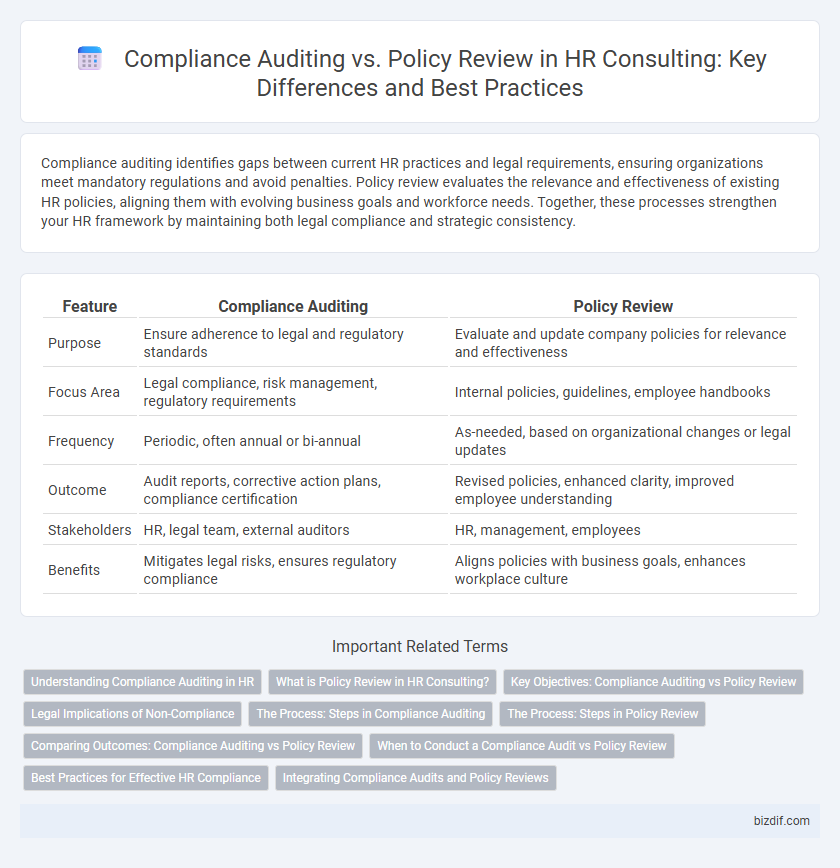Compliance auditing identifies gaps between current HR practices and legal requirements, ensuring organizations meet mandatory regulations and avoid penalties. Policy review evaluates the relevance and effectiveness of existing HR policies, aligning them with evolving business goals and workforce needs. Together, these processes strengthen your HR framework by maintaining both legal compliance and strategic consistency.
Table of Comparison
| Feature | Compliance Auditing | Policy Review |
|---|---|---|
| Purpose | Ensure adherence to legal and regulatory standards | Evaluate and update company policies for relevance and effectiveness |
| Focus Area | Legal compliance, risk management, regulatory requirements | Internal policies, guidelines, employee handbooks |
| Frequency | Periodic, often annual or bi-annual | As-needed, based on organizational changes or legal updates |
| Outcome | Audit reports, corrective action plans, compliance certification | Revised policies, enhanced clarity, improved employee understanding |
| Stakeholders | HR, legal team, external auditors | HR, management, employees |
| Benefits | Mitigates legal risks, ensures regulatory compliance | Aligns policies with business goals, enhances workplace culture |
Understanding Compliance Auditing in HR
Compliance auditing in HR involves systematically evaluating organizational practices to ensure adherence to labor laws, industry regulations, and internal policies, minimizing legal risks and penalties. This process includes reviewing employee records, payroll systems, and workplace safety measures to identify compliance gaps and ensure corrective actions are implemented. HR compliance audits support maintaining regulatory standards, fostering transparency, and enhancing overall workforce governance.
What is Policy Review in HR Consulting?
Policy review in HR consulting involves systematically examining an organization's existing HR policies to ensure alignment with current labor laws, industry standards, and company objectives. This process identifies outdated, ambiguous, or non-compliant policies and recommends necessary updates to mitigate legal risks and enhance employee relations. Effective policy review supports regulatory compliance, promotes workplace consistency, and fosters a positive organizational culture.
Key Objectives: Compliance Auditing vs Policy Review
Compliance auditing focuses on verifying adherence to legal regulations, industry standards, and internal controls to identify gaps and mitigate risks. Policy review aims to ensure organizational policies are up-to-date, clear, and aligned with current laws and business objectives to guide employee behavior effectively. Both processes enhance governance but differ in scope: auditing is retrospective and control-focused, while policy review is proactive and strategic.
Legal Implications of Non-Compliance
Non-compliance in HR practices can lead to significant legal consequences, including fines, lawsuits, and reputational damage, making compliance auditing essential for identifying regulatory gaps and ensuring adherence to labor laws. Policy review focuses on updating internal HR guidelines to align with current legal standards, minimizing the risk of violations before they occur. Both processes are critical for mitigating legal risks and protecting organizations from costly penalties related to employment law breaches.
The Process: Steps in Compliance Auditing
Compliance auditing involves a systematic process beginning with planning and risk assessment to identify relevant laws and regulations affecting the organization. This is followed by data collection through interviews, document examinations, and observations to verify adherence to compliance standards. The final steps include evaluating findings against regulatory requirements, reporting discrepancies, and recommending corrective actions to ensure ongoing legal and ethical compliance.
The Process: Steps in Policy Review
Policy review in HR consulting involves systematically evaluating existing company policies to ensure alignment with current laws, regulations, and organizational goals. The process includes gathering all relevant policy documents, analyzing their content for accuracy and compliance, and identifying areas requiring updates or improvements. Final steps involve consulting with key stakeholders to incorporate feedback and formalizing revisions to maintain regulatory adherence and operational effectiveness.
Comparing Outcomes: Compliance Auditing vs Policy Review
Compliance auditing identifies gaps in adherence to legal regulations and internal standards, providing a concrete evaluation of risk exposure and operational effectiveness. Policy review focuses on aligning company policies with evolving laws, corporate goals, and industry best practices to enhance clarity and governance. Together, these processes ensure robust regulatory compliance and strategic policy management, reducing the risk of sanctions and improving organizational accountability.
When to Conduct a Compliance Audit vs Policy Review
Conduct a compliance audit when assessing an organization's adherence to legal regulations, industry standards, and internal policies, typically triggered by regulatory changes, risk management needs, or prior audit findings. Schedule a policy review regularly or when significant operational shifts occur, such as new business processes, technological advancements, or changes in workforce structure, to ensure policies remain relevant and effective. Timing these efforts strategically enhances regulatory compliance, reduces risk exposure, and promotes a culture of continuous improvement in HR practices.
Best Practices for Effective HR Compliance
Compliance auditing ensures adherence to labor laws and internal policies by systematically examining HR processes, records, and practices. Policy review involves regularly updating HR guidelines to reflect current regulations and organizational changes, mitigating legal risks and promoting fairness. Implementing a combined approach with clear documentation, employee training, and continuous monitoring enhances HR compliance effectiveness and prevents costly violations.
Integrating Compliance Audits and Policy Reviews
Integrating compliance audits and policy reviews creates a robust framework that ensures organizational adherence to legal and regulatory standards while continuously refining internal policies. This approach enables HR consulting firms to identify gaps in compliance, streamline policy updates, and mitigate risks associated with non-compliance. Effective integration leverages data-driven insights to enhance decision-making, promote accountability, and maintain alignment with evolving labor laws and industry regulations.
Compliance Auditing vs Policy Review Infographic

 bizdif.com
bizdif.com